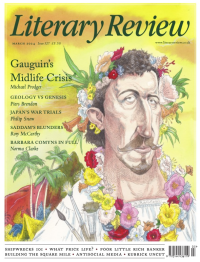Alan Powers
More Than Modernism
Interwar: British Architecture 1919–39
By Gavin Stamp
Profile 576pp £40
Architecture in Britain from 1919 to 1939 should form a conveniently self-contained slice of history. Since the moment that Neville Chamberlain announced on the airwaves on 3 September 1939 that Britain was at war with Germany for a second time, everything about this period has been analysed and revisited. Of course, architecture has not been neglected in these appraisals. But despite all the arts confirming Osbert Lancaster’s view (expressed in 1939) that it was ‘a period in describing which the phrase Transitional, it is now apparent, is the grossest of understatements’, there has never been a comprehensive overview of its architecture, such as Gavin Stamp has provided in his posthumously published Interwar.
There are several reasons why this might be. The most important, perhaps, is one that Stamp himself struggled with over many decades: the sharp division in critical opinion distinguishing the Modern Movement (concrete, steel, flat roofs and so on) from the rest. Not since the Gothic Revival in the previous century had a minority of architects set themselves apart from the rest with such determination, adding to stylistic preference a conviction that their way alone would lead to salvation on earth and in heaven.
Always inclined to oppose orthodoxies, Stamp used his early study of such architects as Sir Edwin Lutyens and Sir Giles Gilbert Scott as a way of contesting the dominance that the ‘pioneers of the Modern Movement’ had long been assigned in the historiography of the period. This approach, associated above all with Nikolaus Pevsner, involved selecting a few key examples that appear to ‘lead towards’ a promised land and rejecting all other creations as fundamentally wrong, whatever qualities they might display. As Stamp’s early mentor, David Watkin, explained in Morality and Architecture (1977), not the least of the shortcomings of this method is a deliberate blindness to meritorious work that, like Sir Walter Raleigh in 1066 and All That, is deemed to be living in the wrong reign and therefore has to be chopped. Furthermore, the promised land revealed itself, in John Betjeman’s words, to be ‘a bit of a disappointment’ (in Stamp’s view a place of totalitarian tyranny), so there were good reasons to excavate alternatives.
Anticipating a reiteration of the old orthodoxy in the major ‘Thirties’ exhibition at the Hayward Gallery in 1979, Stamp, who had previously concerned himself with Victorian and Edwardian architecture, compiled a special issue of Architectural Design entitled ‘Britain in the Thirties’. Eclectic figures on the borderline of tradition and modernism,

Sign Up to our newsletter
Receive free articles, highlights from the archive, news, details of prizes, and much more.@Lit_Review
Follow Literary Review on Twitter
Twitter Feed
Under its longest-serving editor, Graydon Carter, Vanity Fair was that rare thing – a New York society magazine that published serious journalism.
@PeterPeteryork looks at what Carter got right.
Peter York - Deluxe Editions
Peter York: Deluxe Editions - When the Going Was Good: An Editor’s Adventures During the Last Golden Age of Magazines by Graydon Carter
literaryreview.co.uk
Henry James returned to America in 1904 with three objectives: to see his brother William, to deliver a series of lectures on Balzac, and to gather material for a pair of books about modern America.
Peter Rose follows James out west.
Peter Rose - The Restless Analyst
Peter Rose: The Restless Analyst - Henry James Comes Home: Rediscovering America in the Gilded Age by Peter Brooks...
literaryreview.co.uk
Vladimir Putin served his apprenticeship in the KGB toward the end of the Cold War, a period during which Western societies were infiltrated by so-called 'illegals'.
Piers Brendon examines how the culture of Soviet spycraft shaped his thinking.
Piers Brendon - Tinker, Tailor, Sleeper, Troll
Piers Brendon: Tinker, Tailor, Sleeper, Troll - The Illegals: Russia’s Most Audacious Spies and the Plot to Infiltrate the West by Shaun Walker
literaryreview.co.uk